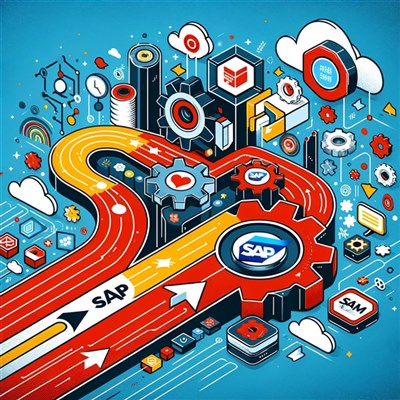.pngL.jpg)
In simple words, VMware is responsible for developing software for virtualisation. Virtualisation software works by creating an abstraction layer that lies over system hardware. This layer enables hardware elements of a computer - memory, storage, processors etc. - to be segmented into several virtual machines (VMs) or virtual computers. A single virtual machine has a working OS (operating system) and functions as an independent PC despite consisting of only a small part of a PC’s hardware.
In this way, virtualisation allows more efficient and optimised usage of system hardware and allows higher returns on an enterprise’s hardware investments. Both public and private cloud providers are also empowered to cater to a larger number of users with existing hardware.
Large sections of today’s business enterprises depend on virtualisation for scaling up more efficiently and cutting down on the costs of buying and maintaining hardware. Today, VMware vSphere is undoubtedly the most prominent and popular server virtualisation tool in the market.
If you are just getting started and don’t know much about VMware products and virtualisation, you should first probably know what vSphere is and where it fits in the bigger picture of ensuring that your organisation can stay ahead of high storage and processing demands through virtualisation.
Understanding Virtualisation:
An x86 or a 32-bit CPU is limited in its capacity, in terms of things it can do or the information it can store. In today’s digital-first world, data is flowing in fast and in huge volumes. Consequently, technology enterprises required several servers operating at a limited portion of their maximum capacity so that they could keep up with the incoming data. However, when it comes to efficiency and operating costs, this is not the most beneficial way to work.
With virtualisation, businesses can depend on cloud-based solutions to imitate a physical server and create multiple virtual servers. This means IT departments and organisations can run several virtual machines using just one server. Virtualisation makes using hardware and servers more efficient and cost-effective as compared to purchasing several physical machines to work in a single environment.
Virtualisation can be categorised into three types.
-
Server Virtualisation:
This allows organisations to run more than one server on a single machine as compared to having multiple physical machines. A virtual server allows enterprises to get more efficient as they minimise operating costs, deploy workloads more efficiently, improve overall performance and remove needless server sprawl and complexity.
-
Network Virtualisation:
This type of virtualisation recreates a physical network entirely, which results in applications functioning more freely and independent of breakable hardware. When network virtualisation is enabled, communication and data sharing can be done between multiple computers across various locations.
-
Desktop Virtualisation:
When employees need to access their work computers when they don’t have the hardware before them, desktop virtualisation is enabled. This type of virtualisation enables IT enterprises and departments to respond much faster to opportunities and business needs, which allows remote employees, other office branches and outsourced teams to get all the relevant data without shipping the physical hardware to their locations.
You May Also Like: 7 New VMware Courses To Get You Ready for vSphere 7
What is vSphere?
To understand vSphere, you need to understand all the features of vSphere and its various components that work together.
-
VMware ESXi:This is a Type 1 hypervisor. ESXi is responsible for conceptualising storage, processes and memory into several machines, along with other sources. It also has a VM File System to provide users with a cluster file system with higher performance for VMs.
-
vCentre Server:Formerly called the Virtual Centre, a vCentre Server refers to a management tool which acts like a control hub for all services of the data centre. It also manages ESXi and offers the vSphere API. Additionally, vSphere 6.5 helps users to choose between virtual appliances (vCSA) and Windows Server while allowing Host Profiles that enable users to define ESXi rules for specific hosts.
-
vSphere Client: vSphere Client is an interface based on HTML5 that provides access to users for connecting to vCenter remotely.
-
vSphere Distributed Switch: A distributed switch allows virtual switches to connect with multiple hosts together to optimise network management.
-
Virtual SMP: Individual VMs can use multiple processors at the same time by using virtual SMPs.
-
vMotion/ Storage vMotion: Both vMotion and Storage vMotion allow live migration when VMs are operational and running. However, Storage vMotion enables users to transfer configuration files or virtual disks.
-
High Availability: This feature of vSphere makes use of other available servers for restarting VMs that might have failed.
-
Software Development Kits (SDK): An SDK provides a user with an interface that grants access to specific parts of vSphere.
-
Fault Tolerance: Having the fault tolerance function helps in creating a selected workload’s copies on various servers so that continuous availability of the workload is ensured.
-
DRS/ Storage DRS: DRS helps to balance computing capacity. Storage DRS is applied to storage capacity and input and output across collections of the datastore.
Also Read: 6 Things You Need to Know about VMware certification
Benefits of vSphere VMware for Virtualisation:
1. Higher ROI:
VMware lets you use more resources from a single physical computer. If one app crashes on a single-server OS, it can destabilise and crash various applications on the same server. The previous alternative to this was running a single application on a dedicated physical server. However, this was highly inefficient and drove up operational costs. With VMware, each application can be run on its own operating system using the same physical server while making better use of the available CPU power of the hardware server.
2. Increased efficiency while using space and energy:
VMware enables enterprises to run many more apps while reducing the required physical servers. This means your data centre will need less space to store and energy to power the physical hardware.
3. Increasing industry support:
VMware is the world’s leading virtualisation service provider and has more than 500,000 global customers. It has a 75,000-partner network that provides customers with support for multiple additional products and services.
If you are looking to switch careers and choose a new technology, virtualisation is the right domain to choose. Give your career the boost it needs and enroll in a training course for vSphere today.





(1).pngM.jpg)
.pngM.jpg)
COMMENT